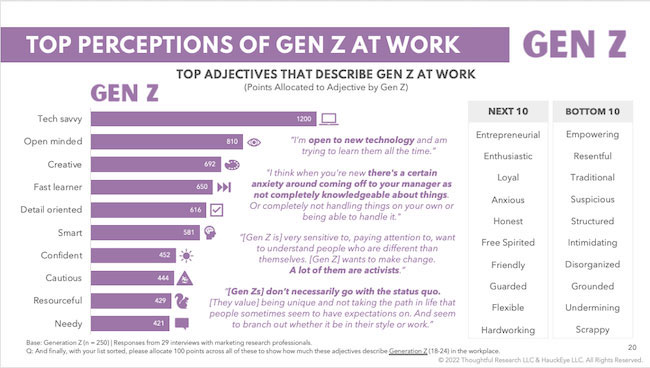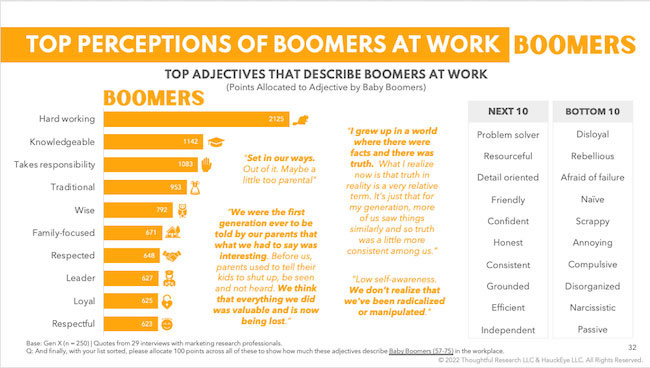Gen Z and Boomers
Editor’s note: Chris Hauck is the founder of Hauckeye. This is an edited version of an article that originally appeared under the title “Generations at Work.”
During our qualitative research we interviewed other researchers to develop our set of 99 attributes used to describe each generation. In the quantitative phase, 1000 respondents (250 per generation) rank ordered the top attribute statements that describe their own generation, and in the next question, they allocated 100 points across their top five attributes. They repeated the exercise to describe how they view each of the three other generations as well.
Gen Z at work
Older generations generally see younger generations as being especially tech savvy. This isn’t surprising, as younger generations tend to be so much more comfortable with technology than those who were introduced to computers and mobile devices as adults. But this allocation of points for tech savvy as the primary attribute is a simple reminder that older generations miss many strong positives of younger generations in the workplace that extend far beyond their ability to use technology. If you see everyone who is younger as being a walking mobile device, you miss out on all the other things young individuals bring to your organization. Those same young people see themselves somewhat differently. Of course, they see themselves as tech savvy compared to others at work; how could they not? But they offer so many additional positive traits to organizations. Each Gen Z individual brings their own unique strengths to your organization. To get the most from your team, it’s more important to find those unique strengths and meet their individual needs rather than focus on the stereotypes.

Boomers at work
Alternatively, let’s look at Boomers. How are Boomers perceived at work?
Most important to this generation is that they are seen as hard working. If you remember, the superstars in our organizations in the ‘80s and ‘90s were the hard workers, wearing that as a badge of honor. This is the era in which we counted our hours like we were all a bunch of lawyers. Even if your organization didn’t measure performance in terms of time, you still knew who was putting in the time. You knew who was there on the weekends and putting in the late nights. Today, younger generations don’t measure performance in terms of hard work and hours – they celebrate accomplishment, particularly in terms of getting the job done efficiently and then having balance in one’s life.
Boomers celebrate that hard work ethic in themselves and see themselves as particularly hard working. These stereotypes create a cultural dissonance between younger and older team members. Younger people are often seen as trying to find those teams that allow them to have a life, while a loud subset of older team members wonder why these kids are always trying to find time to be out of the office.

Generational stereotypes
These negative stereotypes and perceptions aren’t serving us. Our ancestors used stereotyping to quickly assess the dangers around them so they could run or fight when needed. Today, these stereotypes are driving disconnection in working groups because people aren’t taking the time to fully understand the unique value and needs of their coworkers. We can make more sophisticated evaluations and find the plusses in every contributor to make the best work team for all contributors.
Perception management, using tools to understand and empathize with our team members, has the power to build strong teams that are far more effective and far more enjoyable than traditional hierarchical teams.
